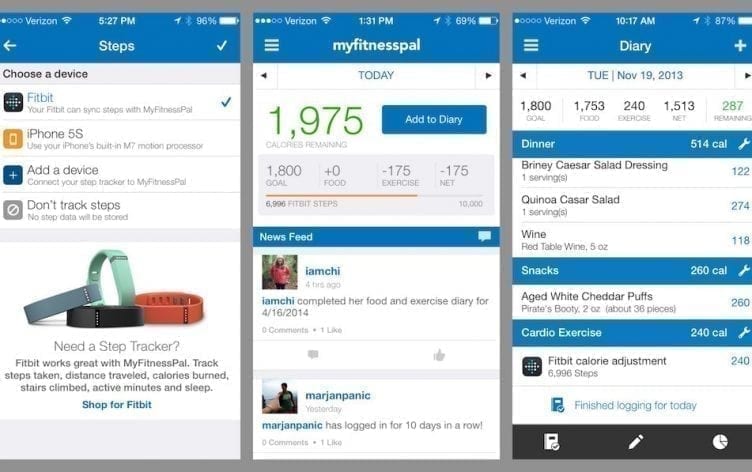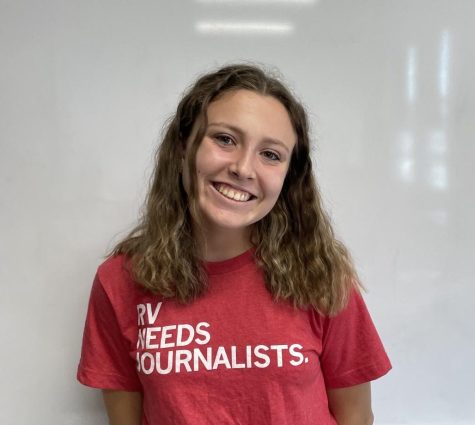Tackling the Junior Health Project
The development behind — and potential future of — the controversial health project students complete their junior year
Photo courtesy of myfitnesspal.com (Meadow Drapala)
The interface of the My FitnessPal app, which helps to track a number of different health aspects for users
April 22, 2022
In freshman health, the focus is on keeping students safe from their own decisions. Then in sophomore health, it is to teach driver’s education so students won’t drive their car into a mailbox. Meanwhile, senior health gets students ready for the real world with life-saving tactics like CPR. So what is the purpose of junior health and, more importantly, the notorious junior health project?
Tara Simmons, a junior who took health this year, explained the project.
“We are supposed to plug in everything that we eat and drink over a span of five days,” she explained. The students then transfer that information to a chart in their fitness portfolios to examine the nutrients they consume in order to create a healthier food plan. The purpose of the project is to encourage students to become more aware of what (and how much) they are consuming.
Over the years, the project has been modified to suit the student population. To decrease the risk of triggering students who may be more sensitive to food-tracking, the project was changed from 14 days to 5. However, some students still worry that this isn’t enough.
“I just feel that this [project] could lead to eating disorders,” Isabella Kwiatkowski, a junior at RV, said. “Being in high school, I know that there are already a lot of people who suffer from this and this might only make it worse for them.”
Mr. Lamb, the supervisor of health and physical education at RV, addressed this concern. When necessary, such as for people with sensitivities to food-tracking, Mr. Lamb said, “they’ll assign some other type of project.”
“Nothing that we select as a project or an assignment or part of the curriculum of that class is ever meant to upset any of our students,” he said. “We’re trying to educate our students for what’s down the road in the future.”
The reason some students need to modify the project stems from the app used: MyFitnessPal. A common misconception about the project is that it’s for calorie tracking. While the app can be used for that, it is also a helpful tool for looking at macronutrients. Macronutrients are the main nutrients your body requires in large amounts: carbohydrates, fats and proteins. Without enough of them, students risk facing the symptoms of poor nutrition, like fatigue. While it may not be sustainable to track anything for a long period of time due to inaccuracies in any tracking, having a glimpse into current habits can help students understand what they need to do if a change is necessary for their health.
“The purpose of everything is to make you aware of the positives you get out of eating the right foods or the positives you get out of exercising, and I think that’s the message with all of our curriculum,” said Mr. Lamb.
Mrs. Marquess, a physical education teacher, says the junior health project has “always been about learning the six essential nutrients and tracking those,” as well as “being a more mindful eater.” When Marquess introduces the project to her classes, she is cautious about students who may be more sensitive to this topic and makes sure students understand “the focus is not on calories.”
“It’s more about the nutrients themselves,” she said. If students aren’t able to look at the calories due to obsessive thoughts, that’s when a student could ask their teacher for a modification.
However, some students are too afraid (or unwilling) to advocate for themselves if this project is triggering. Nutrition is so individualized; everyone has a different gut microbiome and will absorb their foods (and calories) differently. It makes sense that the project should have some degree of individualization too. One student may start calorie tracking and learn they need to eat more, but another may use it as an excuse to restrict. What works for one person may not work for another.
So how do we cater the project to different students’ needs? The solution could come this summer. Every few years, the junior health curriculum is reevaluated. Marquess spoke about a way to “rewrite the project to be more individualized.” If the curriculum was changed to incorporate multiple options, vulnerable students could be less exposed to unnecessary challenges by choosing what works best for them. The problem is finding the right app to be the second option.
While MyFitnessPal focuses on tracking specific calories and nutrients, there are apps that focus on mindful eating. An example of this is the app Ate, which is a food journal that does not track any calories. All you have to do is take a picture of your meal or type in a quick text, and questions will pop up to get you thinking about how it made you feel, as well as why and where you ate. It even has intuitive eating challenges you can choose from, such as eating with your non-dominant hand or taking deep breaths, to help people who struggle with mindless eating.
The problem with apps like this is that they lack the nutrient tracking necessary to get the full benefit of the junior health project. There would have to be a separate app to examine nutrients. Some apps, like ShopWell, can scan foods so you can see what the health value is, but it would be more complicated to track than doing the project in one app.
For this reason, there has to be a better option out there (even if it hasn’t been invented yet). While MyFitnessPal might work fine for some people, the ideal option would be if there was another app that still tracked nutrients but without the calories. Maybe someone in engineering could even make one. While there are various apps that track protein intake without calories, it is more difficult to find one that tracks all the same nutrients as MyFitnessPal without having a calorie intake.
One day, the junior health project may be able to change into something individualized for different students’ needs, but to do so, we have to find a suitable alternative. In the meantime, the important thing to remember is that the project is not about calories; it’s only to get a glance at your overall nutrition (and it’s not supposed to be, or capable of being, completely accurate). It’s to help you learn more about what you are fueling your body with, not to make you feel guilty. If looking at the app is triggering for you, then it might be time to talk to your health teacher about other options.
At a glance, the junior health curriculum may seem harsh, from nutrient tracking to mental illness and addiction. In fact, it is tough, but it’s that way for a reason. These teachers are here to prepare you for life so that you don’t wake up one day in college facing it all alone. They are here to go through it with you.








